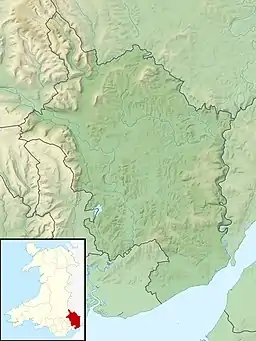Tal-y-coed Court
Tal-y-coed Court,, Llanvihangel-Ystern-Llewern, Monmouthshire, Wales, is a Victorian country house. Constructed in 1881–1883, it was built for the Monmouthshire antiquarian Joseph Bradney, author of A History of Monmouthshire from the Coming of the Normans into Wales down to the Present Time. A Grade II* listed building, the house is a "fine historicist essay in the Queen Anne Style, one of the earliest examples in Wales."
| Tal-y-Coed Court | |
|---|---|
.jpg.webp) The gatehouse to Tal-y-coed Court | |
| Type | House |
| Location | Llanvihangel-Ystern-Llewern, Monmouthshire |
| Coordinates | 51.8325°N 2.84126°W |
| Built | 1881 |
| Architect | F. R. Kempson |
| Architectural style(s) | Queen Anne Revival |
| Governing body | Privately owned |
Listed Building – Grade II* | |
| Official name | Tal-y-coed Court |
| Designated | 6 January 1988 |
| Reference no. | 2787 |
Listed Building – Grade II | |
| Official name | Former Stables & Clock House |
| Designated | 6 January 1988 |
| Reference no. | 2788 |
Listed Building – Grade II | |
| Official name | Forecourt Walls & Railings |
| Designated | 6 January 1988 |
| Reference no. | 2789 |
Listed Building – Grade II | |
| Official name | Lodge at Main Entrance to Tal-y-coed Court |
| Designated | 6 January 1988 |
| Reference no. | 2790 |
Listed Building – Grade II | |
| Official name | Gatepiers, Piers and Walls at Main Entrance to Tal-y-coed Court |
| Designated | 27 October 2000 |
| Reference no. | 24324 |
 Location of Tal-y-Coed Court in Monmouthshire | |
History
Colonel Sir Joseph Alfred Bradney, FSA, BA, JP, DL was a soldier who acquired the estate at Tal-y-Coed through purchase and inheritance. In 1881, aged 22, he commissioned F. R. Kempson to build the house[1] on the site of Llanvihangel Hall, which had been part of the estate of Crawshay Bailey.[2] The house cost £10,000, reflecting Bradney's status as High Sheriff of Monmouthshire.[3]
The court, and its stables, are now sub-divided into a number of private residences.[4] The stables and clock tower are designated Grade II,[5] as is the lodge at the entrance to the court.[6] A project is underway (2019) to restore an elaborate horse trough constructed for Bradney on the road from Llantilio Crossenny to Monmouth.[7] The trough also has a Grade II listing.[8] The court's parkland is recorded as a "small late 19th century park and terraced garden".[9]
Description
The house is in a Queen Anne style,[1] which John Newman describes as "not at all what one would expect in South Wales at that date."[1] It is constructed of red brick with ashlar dressings and a brick plinth.[10] Of five bays, it has a large, hipped roof with "lofty dormer windows and high chimneystacks."[1] The interior is "virtually intact and (...) of exceptionally high quality".[11]
Notes
- Newman, p. 297-8.
- Cadw. "Tal-y-coed Court (Grade II*) (2787)". National Historic Assets of Wales. Retrieved 13 June 2019.
- Cadw. "Tal-y-coed Court (Grade II*) (2787)". National Historic Assets of Wales. Retrieved 13 June 2019.
- "3 bedroom semi-detached house for sale in Talycoed, MONMOUTH, NP25". Rightmove.co.uk. Retrieved 2016-11-27.
- Cadw. "Former Stables & Clock House (Grade II) (2788)". National Historic Assets of Wales. Retrieved 13 June 2019.
- Cadw. "Lodge at Main Entrance to Tal-y-coed Court (Grade II) (2790)". National Historic Assets of Wales. Retrieved 13 June 2019.
- "Village Alive Trust". Village Alive Trust. Retrieved 9 June 2019.
- Cadw. "Drinking Trough and Wall opposite Main Entrance Gateway to Tal-y-coed Court (Grade II) (24325)". National Historic Assets of Wales. Retrieved 13 June 2019.
- Parks and Gardens UK. "Talycoed Court". Parks & Gardens. Retrieved 13 June 2019.
- "Tal-Y-Coed Court, Tal-Y-Coed, Llantilio Crossenny". Coflein. Retrieved 2016-11-27.
- Cadw. "Tal-y-coed Court (Grade II*) (2787)". National Historic Assets of Wales. Retrieved 13 June 2019.
Bibliography
- Newman, John (1995). Gwent/Monmouthshire. The Buildings of Wales. London, UK: Penguin. ISBN 0-14-071053-1.